Diploma of Facilities Management: Report on Key Aspects
VerifiedAdded on 2022/11/17
|14
|2424
|76
Report
AI Summary
This report provides a detailed overview of facilities management, beginning with the definition of facilities and facilities management, emphasizing the integration of people, place, and process within the built environment to improve quality of life and productivity. It then explores the scope of FM, differentiating between 'Space & Infrastructure' and 'People & Organization' and highlighting the core competencies identified by IFMA. The report delves into the multifaceted role of the facilities manager, covering crucial aspects such as environment, health and safety (EHS), fire safety, security, maintenance, building maintenance, cleaning, operational responsibilities, business continuity planning, and space allocation. The report also includes a bibliography of cited sources. The report concludes by summarizing the key elements and emphasizing the importance of facilities management in both public and private organizations. It also suggests the inclusion of sustainability in the definition.
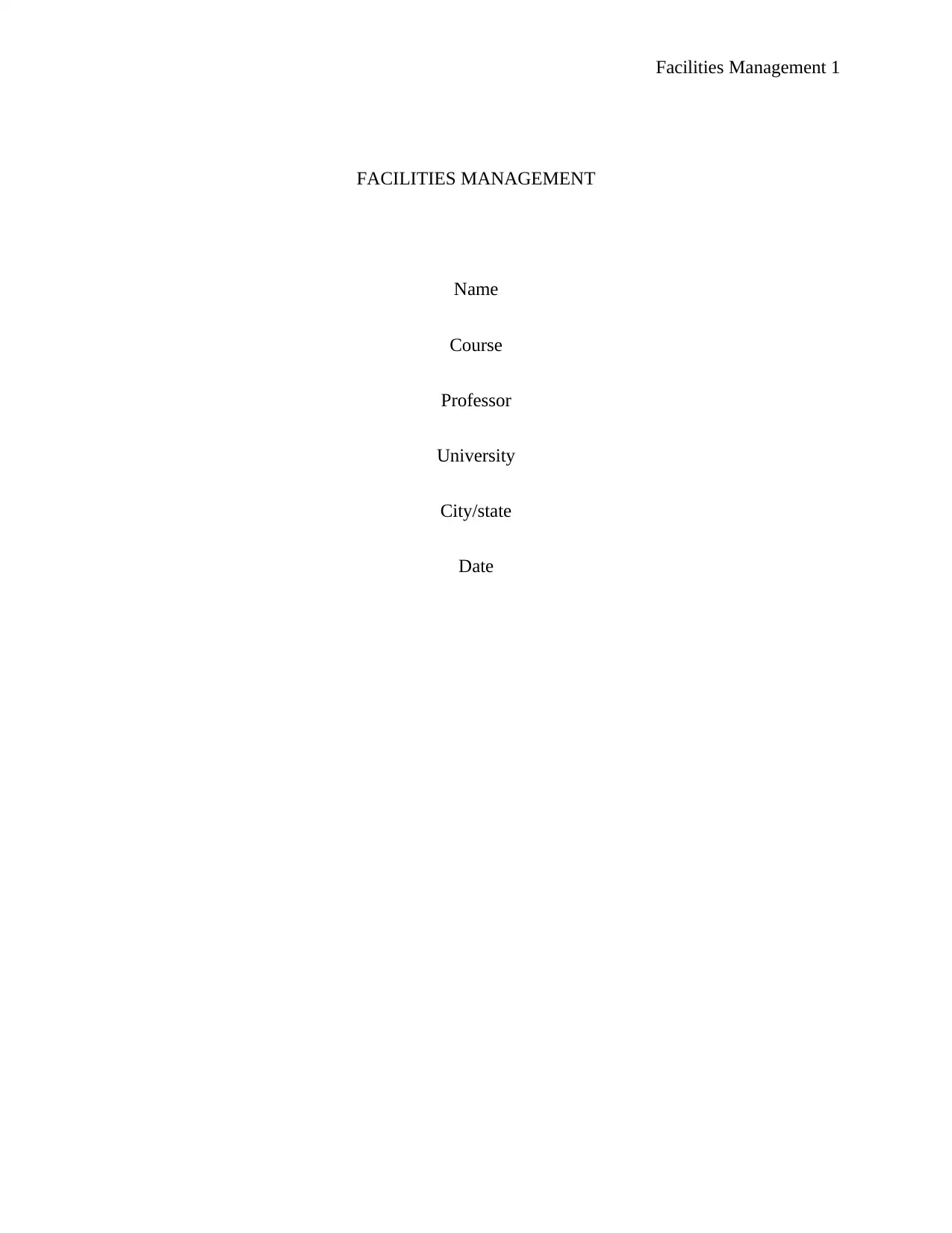
Facilities Management 1
FACILITIES MANAGEMENT
Name
Course
Professor
University
City/state
Date
FACILITIES MANAGEMENT
Name
Course
Professor
University
City/state
Date
Paraphrase This Document
Need a fresh take? Get an instant paraphrase of this document with our AI Paraphraser
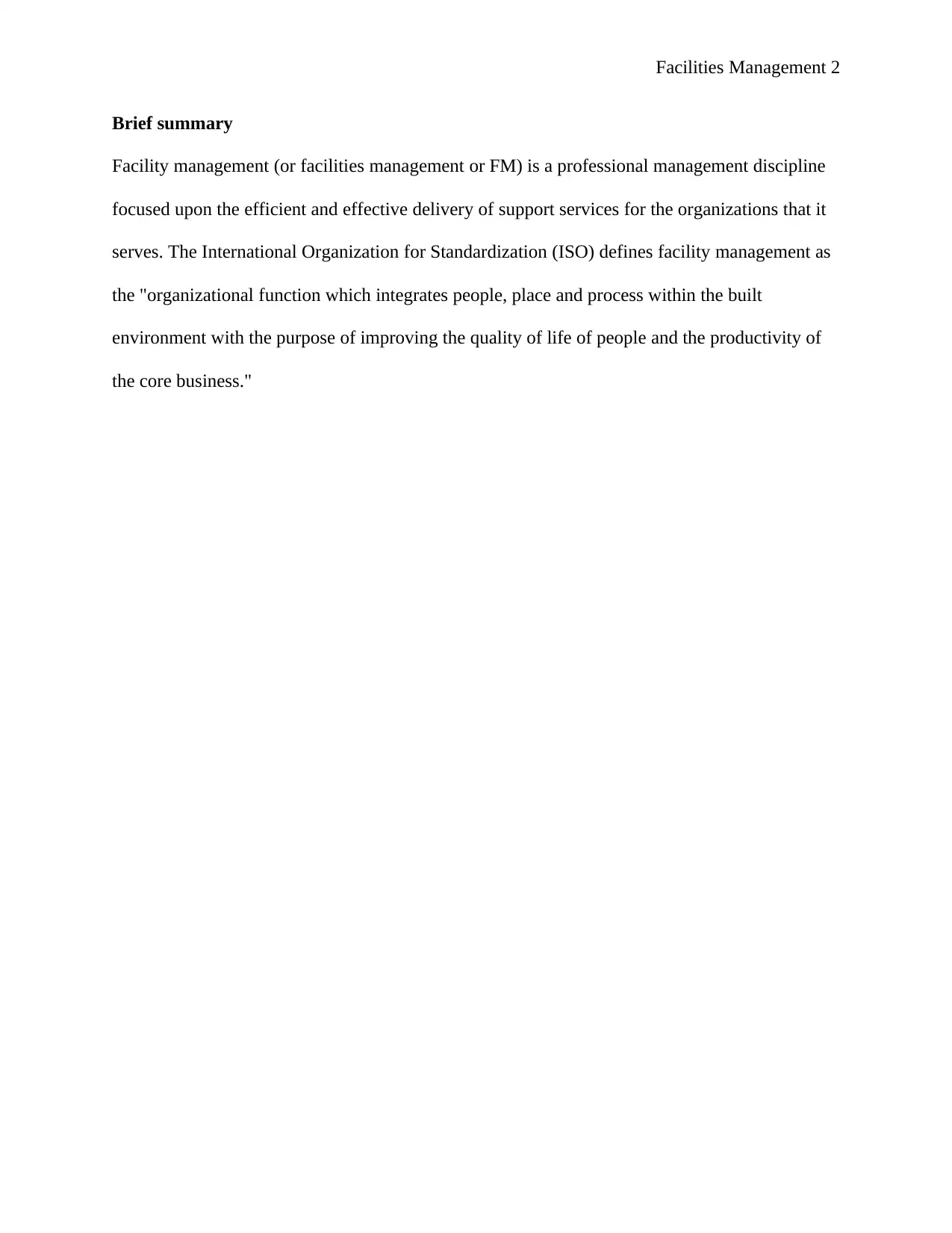
Facilities Management 2
Brief summary
Facility management (or facilities management or FM) is a professional management discipline
focused upon the efficient and effective delivery of support services for the organizations that it
serves. The International Organization for Standardization (ISO) defines facility management as
the "organizational function which integrates people, place and process within the built
environment with the purpose of improving the quality of life of people and the productivity of
the core business."
Brief summary
Facility management (or facilities management or FM) is a professional management discipline
focused upon the efficient and effective delivery of support services for the organizations that it
serves. The International Organization for Standardization (ISO) defines facility management as
the "organizational function which integrates people, place and process within the built
environment with the purpose of improving the quality of life of people and the productivity of
the core business."
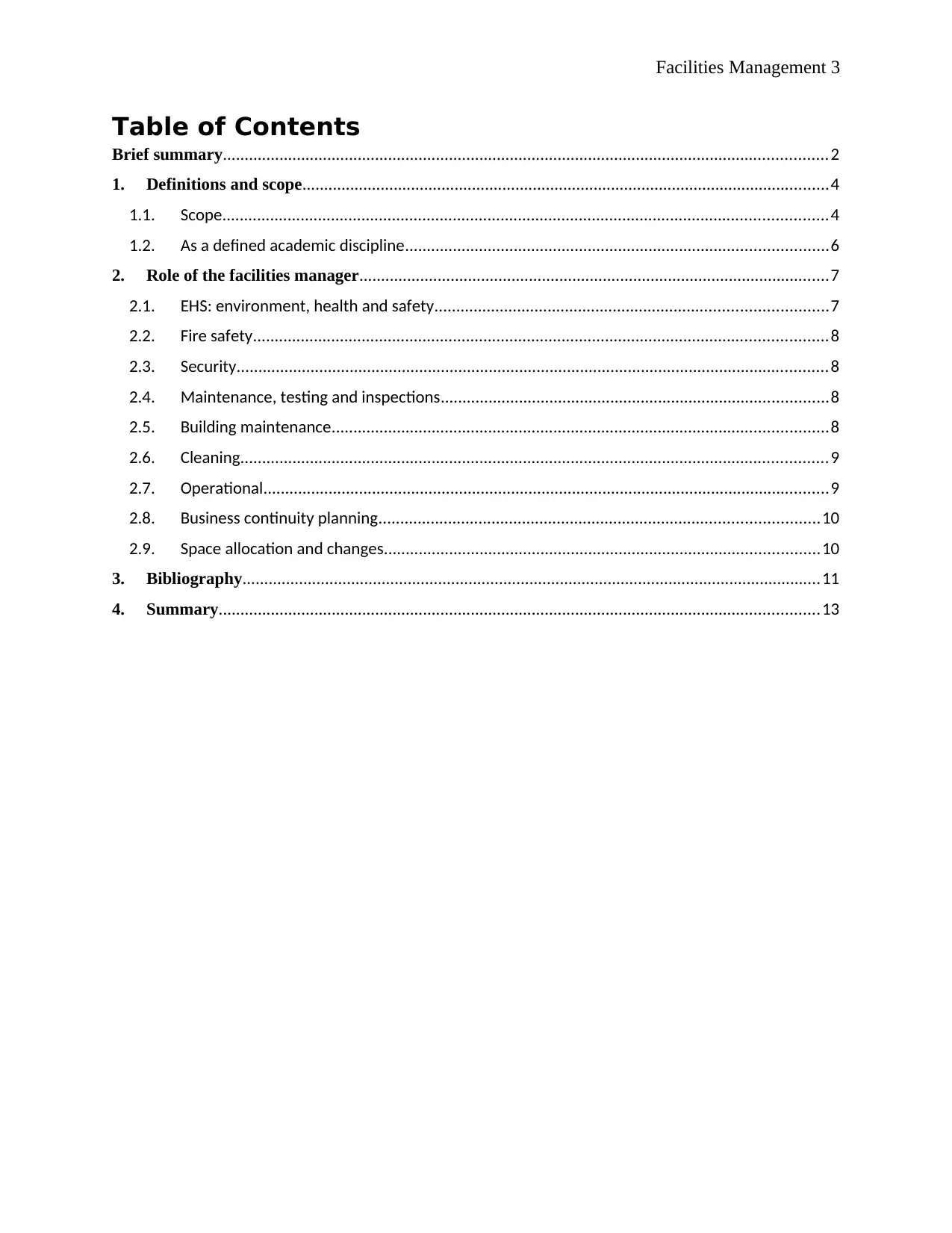
Facilities Management 3
Table of Contents
Brief summary...........................................................................................................................................2
1. Definitions and scope.........................................................................................................................4
1.1. Scope...........................................................................................................................................4
1.2. As a defined academic discipline.................................................................................................6
2. Role of the facilities manager............................................................................................................7
2.1. EHS: environment, health and safety..........................................................................................7
2.2. Fire safety....................................................................................................................................8
2.3. Security........................................................................................................................................8
2.4. Maintenance, testing and inspections.........................................................................................8
2.5. Building maintenance..................................................................................................................8
2.6. Cleaning.......................................................................................................................................9
2.7. Operational..................................................................................................................................9
2.8. Business continuity planning.....................................................................................................10
2.9. Space allocation and changes....................................................................................................10
3. Bibliography.....................................................................................................................................11
4. Summary..........................................................................................................................................13
Table of Contents
Brief summary...........................................................................................................................................2
1. Definitions and scope.........................................................................................................................4
1.1. Scope...........................................................................................................................................4
1.2. As a defined academic discipline.................................................................................................6
2. Role of the facilities manager............................................................................................................7
2.1. EHS: environment, health and safety..........................................................................................7
2.2. Fire safety....................................................................................................................................8
2.3. Security........................................................................................................................................8
2.4. Maintenance, testing and inspections.........................................................................................8
2.5. Building maintenance..................................................................................................................8
2.6. Cleaning.......................................................................................................................................9
2.7. Operational..................................................................................................................................9
2.8. Business continuity planning.....................................................................................................10
2.9. Space allocation and changes....................................................................................................10
3. Bibliography.....................................................................................................................................11
4. Summary..........................................................................................................................................13
⊘ This is a preview!⊘
Do you want full access?
Subscribe today to unlock all pages.

Trusted by 1+ million students worldwide
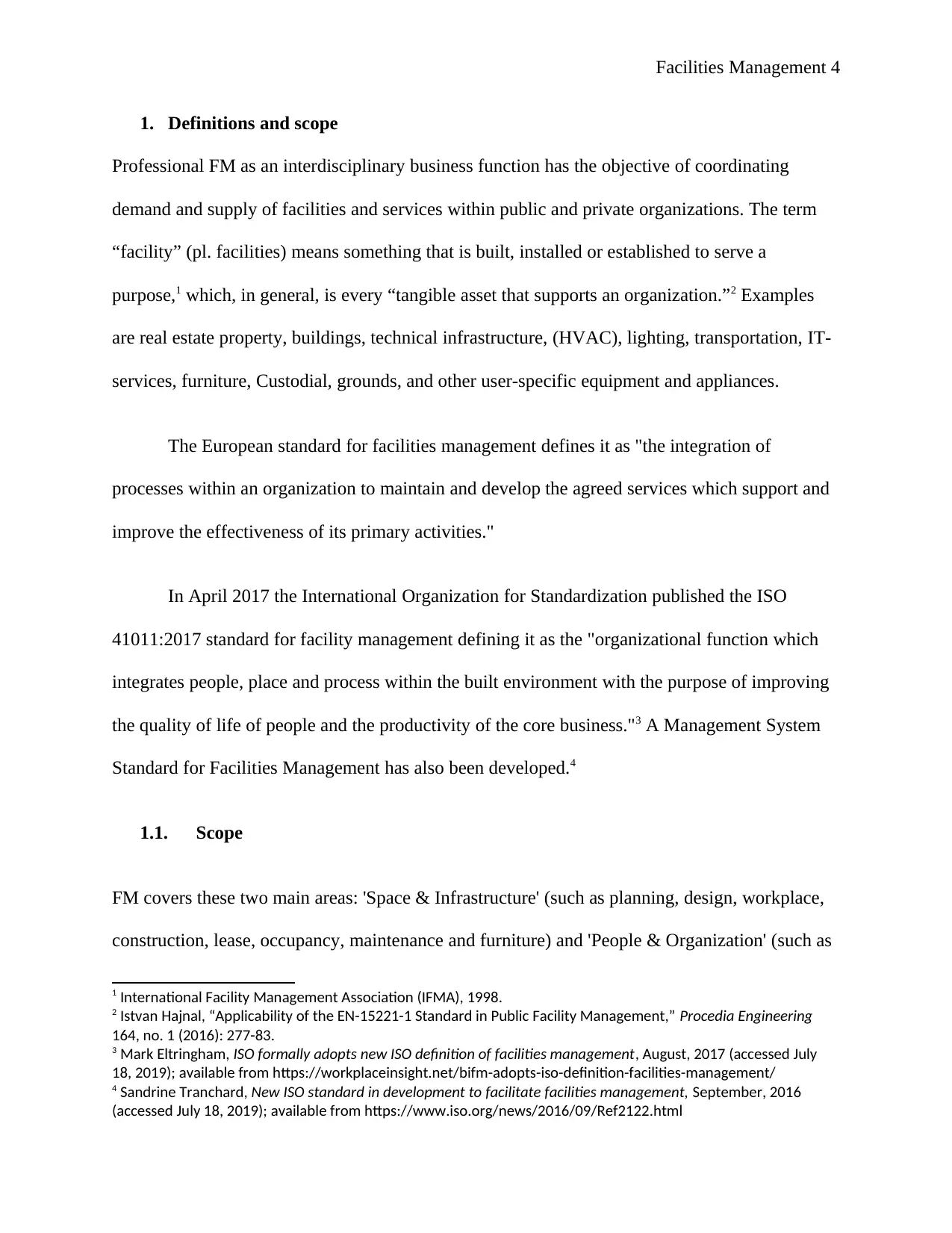
Facilities Management 4
1. Definitions and scope
Professional FM as an interdisciplinary business function has the objective of coordinating
demand and supply of facilities and services within public and private organizations. The term
“facility” (pl. facilities) means something that is built, installed or established to serve a
purpose,1 which, in general, is every “tangible asset that supports an organization.”2 Examples
are real estate property, buildings, technical infrastructure, (HVAC), lighting, transportation, IT-
services, furniture, Custodial, grounds, and other user-specific equipment and appliances.
The European standard for facilities management defines it as "the integration of
processes within an organization to maintain and develop the agreed services which support and
improve the effectiveness of its primary activities."
In April 2017 the International Organization for Standardization published the ISO
41011:2017 standard for facility management defining it as the "organizational function which
integrates people, place and process within the built environment with the purpose of improving
the quality of life of people and the productivity of the core business."3 A Management System
Standard for Facilities Management has also been developed.4
1.1. Scope
FM covers these two main areas: 'Space & Infrastructure' (such as planning, design, workplace,
construction, lease, occupancy, maintenance and furniture) and 'People & Organization' (such as
1 International Facility Management Association (IFMA), 1998.
2 Istvan Hajnal, “Applicability of the EN-15221-1 Standard in Public Facility Management,” Procedia Engineering
164, no. 1 (2016): 277-83.
3 Mark Eltringham, ISO formally adopts new ISO definition of facilities management, August, 2017 (accessed July
18, 2019); available from https://workplaceinsight.net/bifm-adopts-iso-definition-facilities-management/
4 Sandrine Tranchard, New ISO standard in development to facilitate facilities management, September, 2016
(accessed July 18, 2019); available from https://www.iso.org/news/2016/09/Ref2122.html
1. Definitions and scope
Professional FM as an interdisciplinary business function has the objective of coordinating
demand and supply of facilities and services within public and private organizations. The term
“facility” (pl. facilities) means something that is built, installed or established to serve a
purpose,1 which, in general, is every “tangible asset that supports an organization.”2 Examples
are real estate property, buildings, technical infrastructure, (HVAC), lighting, transportation, IT-
services, furniture, Custodial, grounds, and other user-specific equipment and appliances.
The European standard for facilities management defines it as "the integration of
processes within an organization to maintain and develop the agreed services which support and
improve the effectiveness of its primary activities."
In April 2017 the International Organization for Standardization published the ISO
41011:2017 standard for facility management defining it as the "organizational function which
integrates people, place and process within the built environment with the purpose of improving
the quality of life of people and the productivity of the core business."3 A Management System
Standard for Facilities Management has also been developed.4
1.1. Scope
FM covers these two main areas: 'Space & Infrastructure' (such as planning, design, workplace,
construction, lease, occupancy, maintenance and furniture) and 'People & Organization' (such as
1 International Facility Management Association (IFMA), 1998.
2 Istvan Hajnal, “Applicability of the EN-15221-1 Standard in Public Facility Management,” Procedia Engineering
164, no. 1 (2016): 277-83.
3 Mark Eltringham, ISO formally adopts new ISO definition of facilities management, August, 2017 (accessed July
18, 2019); available from https://workplaceinsight.net/bifm-adopts-iso-definition-facilities-management/
4 Sandrine Tranchard, New ISO standard in development to facilitate facilities management, September, 2016
(accessed July 18, 2019); available from https://www.iso.org/news/2016/09/Ref2122.html
Paraphrase This Document
Need a fresh take? Get an instant paraphrase of this document with our AI Paraphraser
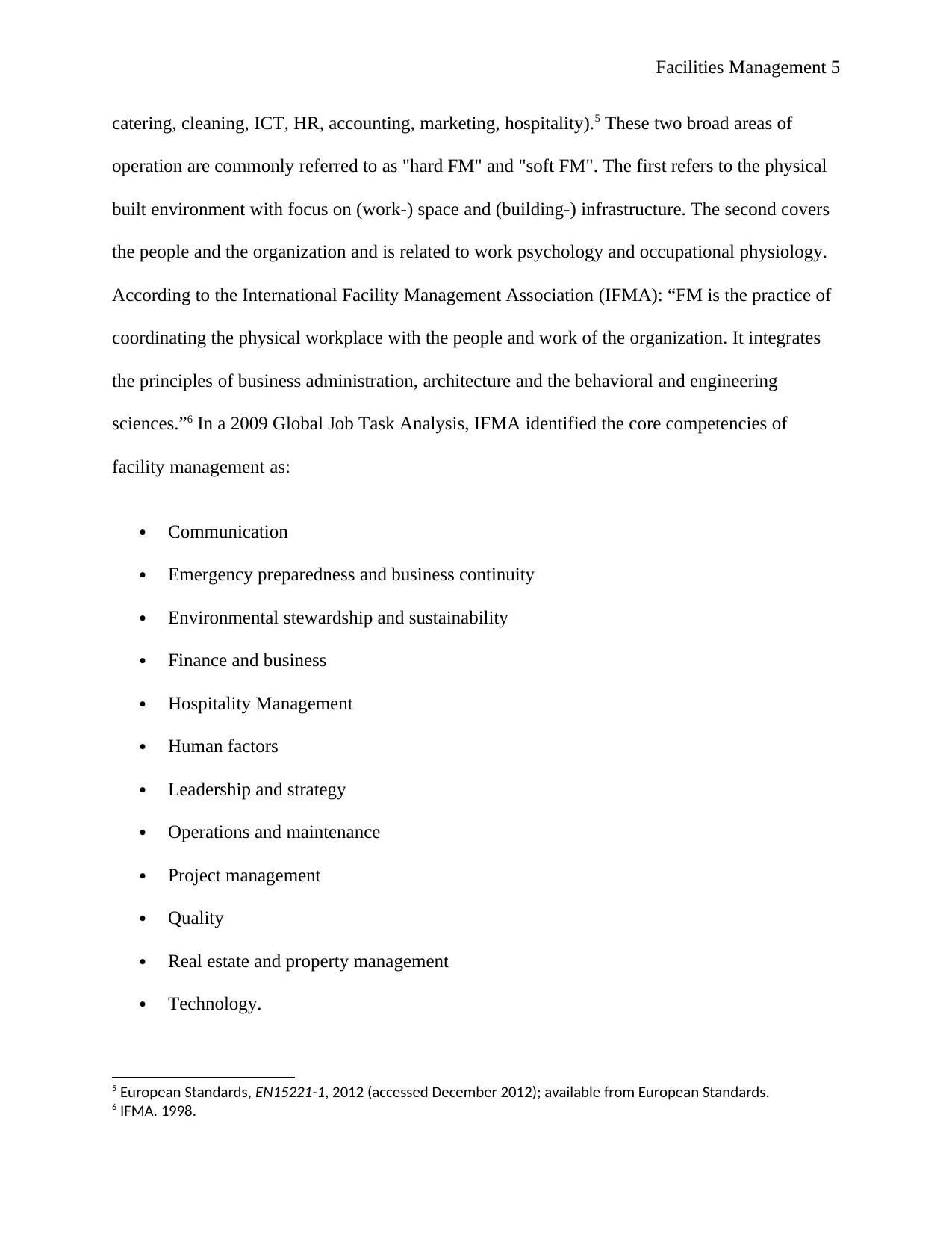
Facilities Management 5
catering, cleaning, ICT, HR, accounting, marketing, hospitality).5 These two broad areas of
operation are commonly referred to as "hard FM" and "soft FM". The first refers to the physical
built environment with focus on (work-) space and (building-) infrastructure. The second covers
the people and the organization and is related to work psychology and occupational physiology.
According to the International Facility Management Association (IFMA): “FM is the practice of
coordinating the physical workplace with the people and work of the organization. It integrates
the principles of business administration, architecture and the behavioral and engineering
sciences.”6 In a 2009 Global Job Task Analysis, IFMA identified the core competencies of
facility management as:
Communication
Emergency preparedness and business continuity
Environmental stewardship and sustainability
Finance and business
Hospitality Management
Human factors
Leadership and strategy
Operations and maintenance
Project management
Quality
Real estate and property management
Technology.
5 European Standards, EN15221-1, 2012 (accessed December 2012); available from European Standards.
6 IFMA. 1998.
catering, cleaning, ICT, HR, accounting, marketing, hospitality).5 These two broad areas of
operation are commonly referred to as "hard FM" and "soft FM". The first refers to the physical
built environment with focus on (work-) space and (building-) infrastructure. The second covers
the people and the organization and is related to work psychology and occupational physiology.
According to the International Facility Management Association (IFMA): “FM is the practice of
coordinating the physical workplace with the people and work of the organization. It integrates
the principles of business administration, architecture and the behavioral and engineering
sciences.”6 In a 2009 Global Job Task Analysis, IFMA identified the core competencies of
facility management as:
Communication
Emergency preparedness and business continuity
Environmental stewardship and sustainability
Finance and business
Hospitality Management
Human factors
Leadership and strategy
Operations and maintenance
Project management
Quality
Real estate and property management
Technology.
5 European Standards, EN15221-1, 2012 (accessed December 2012); available from European Standards.
6 IFMA. 1998.
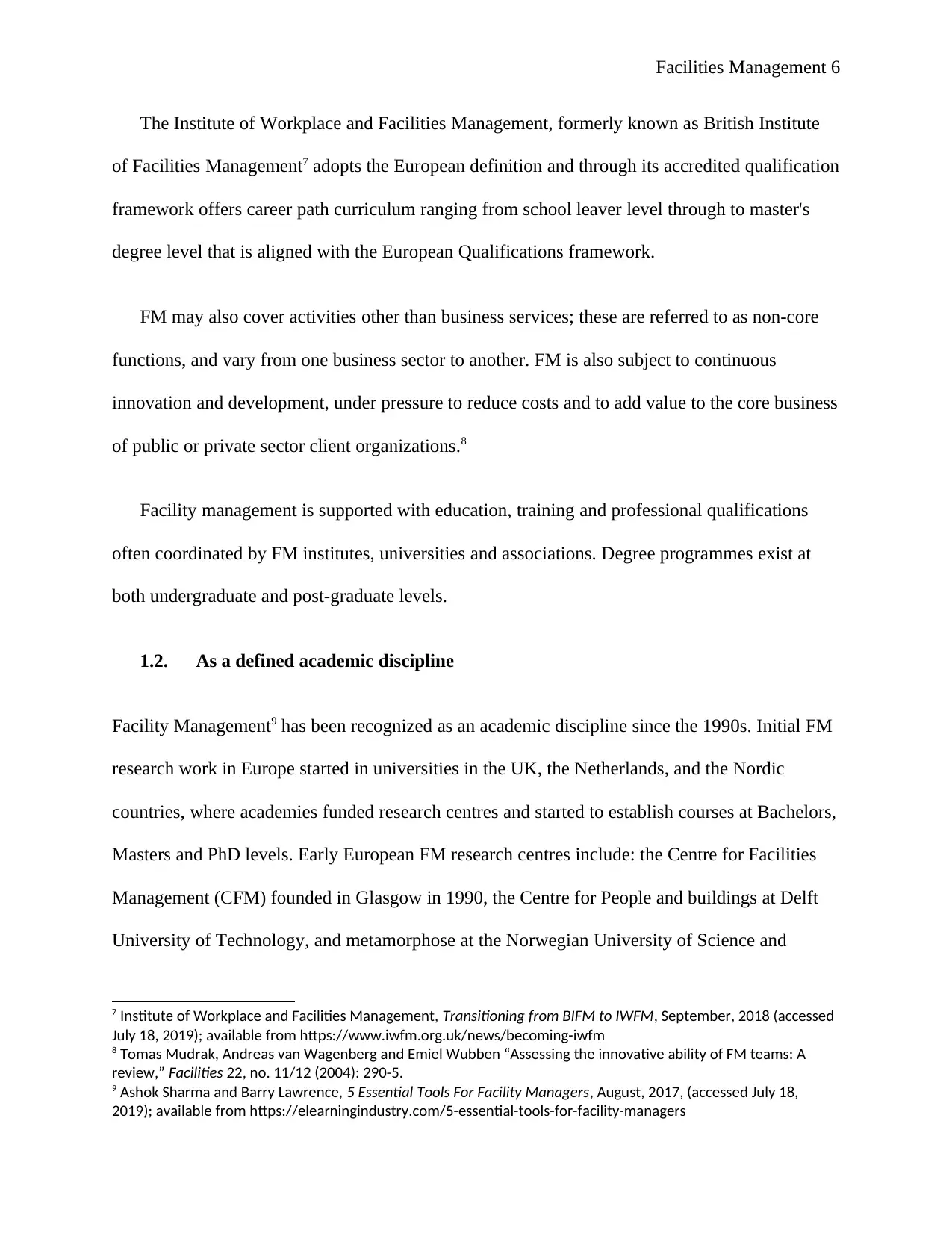
Facilities Management 6
The Institute of Workplace and Facilities Management, formerly known as British Institute
of Facilities Management7 adopts the European definition and through its accredited qualification
framework offers career path curriculum ranging from school leaver level through to master's
degree level that is aligned with the European Qualifications framework.
FM may also cover activities other than business services; these are referred to as non-core
functions, and vary from one business sector to another. FM is also subject to continuous
innovation and development, under pressure to reduce costs and to add value to the core business
of public or private sector client organizations.8
Facility management is supported with education, training and professional qualifications
often coordinated by FM institutes, universities and associations. Degree programmes exist at
both undergraduate and post-graduate levels.
1.2. As a defined academic discipline
Facility Management9 has been recognized as an academic discipline since the 1990s. Initial FM
research work in Europe started in universities in the UK, the Netherlands, and the Nordic
countries, where academies funded research centres and started to establish courses at Bachelors,
Masters and PhD levels. Early European FM research centres include: the Centre for Facilities
Management (CFM) founded in Glasgow in 1990, the Centre for People and buildings at Delft
University of Technology, and metamorphose at the Norwegian University of Science and
7 Institute of Workplace and Facilities Management, Transitioning from BIFM to IWFM, September, 2018 (accessed
July 18, 2019); available from https://www.iwfm.org.uk/news/becoming-iwfm
8 Tomas Mudrak, Andreas van Wagenberg and Emiel Wubben “Assessing the innovative ability of FM teams: A
review,” Facilities 22, no. 11/12 (2004): 290-5.
9 Ashok Sharma and Barry Lawrence, 5 Essential Tools For Facility Managers, August, 2017, (accessed July 18,
2019); available from https://elearningindustry.com/5-essential-tools-for-facility-managers
The Institute of Workplace and Facilities Management, formerly known as British Institute
of Facilities Management7 adopts the European definition and through its accredited qualification
framework offers career path curriculum ranging from school leaver level through to master's
degree level that is aligned with the European Qualifications framework.
FM may also cover activities other than business services; these are referred to as non-core
functions, and vary from one business sector to another. FM is also subject to continuous
innovation and development, under pressure to reduce costs and to add value to the core business
of public or private sector client organizations.8
Facility management is supported with education, training and professional qualifications
often coordinated by FM institutes, universities and associations. Degree programmes exist at
both undergraduate and post-graduate levels.
1.2. As a defined academic discipline
Facility Management9 has been recognized as an academic discipline since the 1990s. Initial FM
research work in Europe started in universities in the UK, the Netherlands, and the Nordic
countries, where academies funded research centres and started to establish courses at Bachelors,
Masters and PhD levels. Early European FM research centres include: the Centre for Facilities
Management (CFM) founded in Glasgow in 1990, the Centre for People and buildings at Delft
University of Technology, and metamorphose at the Norwegian University of Science and
7 Institute of Workplace and Facilities Management, Transitioning from BIFM to IWFM, September, 2018 (accessed
July 18, 2019); available from https://www.iwfm.org.uk/news/becoming-iwfm
8 Tomas Mudrak, Andreas van Wagenberg and Emiel Wubben “Assessing the innovative ability of FM teams: A
review,” Facilities 22, no. 11/12 (2004): 290-5.
9 Ashok Sharma and Barry Lawrence, 5 Essential Tools For Facility Managers, August, 2017, (accessed July 18,
2019); available from https://elearningindustry.com/5-essential-tools-for-facility-managers
⊘ This is a preview!⊘
Do you want full access?
Subscribe today to unlock all pages.

Trusted by 1+ million students worldwide
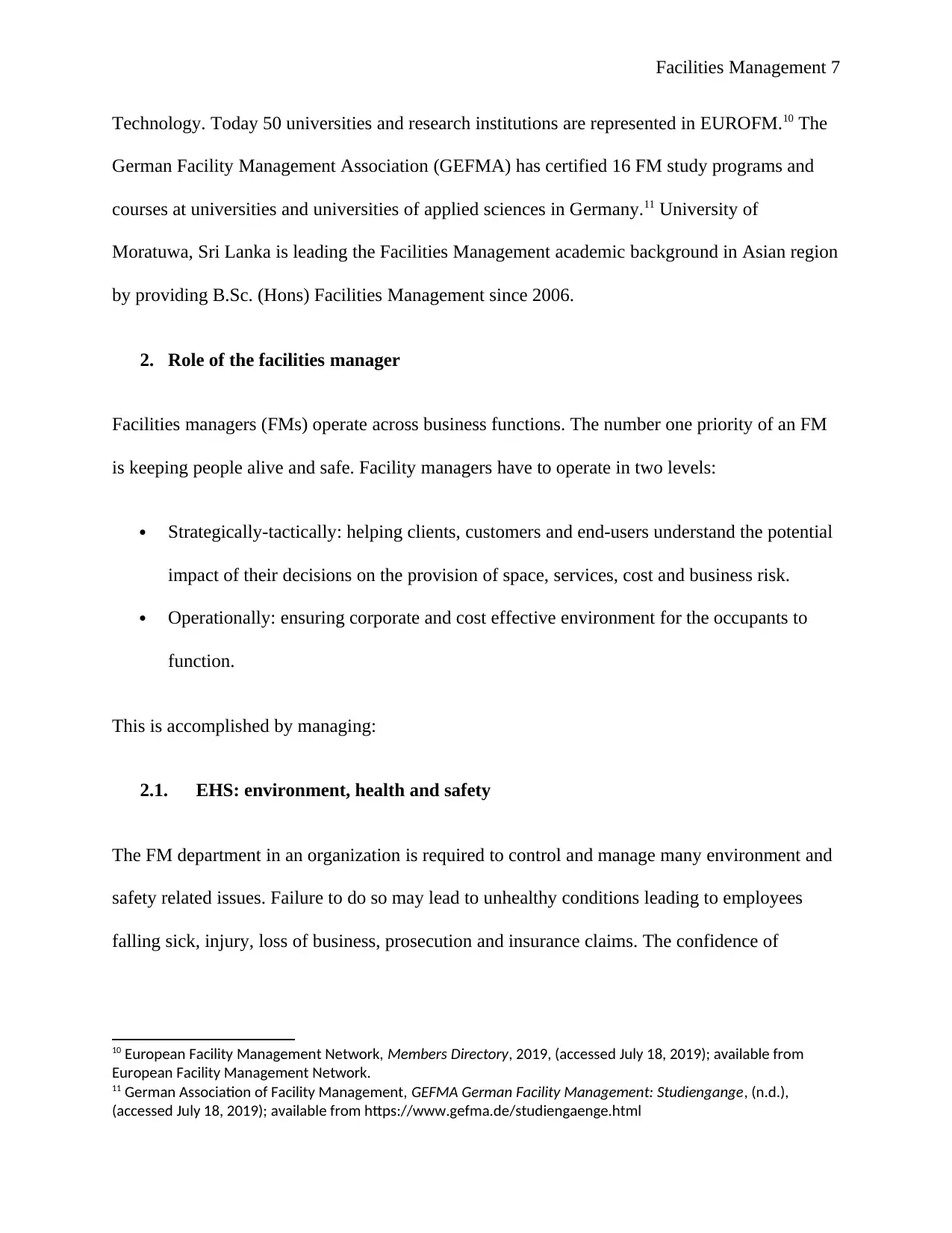
Facilities Management 7
Technology. Today 50 universities and research institutions are represented in EUROFM.10 The
German Facility Management Association (GEFMA) has certified 16 FM study programs and
courses at universities and universities of applied sciences in Germany.11 University of
Moratuwa, Sri Lanka is leading the Facilities Management academic background in Asian region
by providing B.Sc. (Hons) Facilities Management since 2006.
2. Role of the facilities manager
Facilities managers (FMs) operate across business functions. The number one priority of an FM
is keeping people alive and safe. Facility managers have to operate in two levels:
Strategically-tactically: helping clients, customers and end-users understand the potential
impact of their decisions on the provision of space, services, cost and business risk.
Operationally: ensuring corporate and cost effective environment for the occupants to
function.
This is accomplished by managing:
2.1. EHS: environment, health and safety
The FM department in an organization is required to control and manage many environment and
safety related issues. Failure to do so may lead to unhealthy conditions leading to employees
falling sick, injury, loss of business, prosecution and insurance claims. The confidence of
10 European Facility Management Network, Members Directory, 2019, (accessed July 18, 2019); available from
European Facility Management Network.
11 German Association of Facility Management, GEFMA German Facility Management: Studiengange, (n.d.),
(accessed July 18, 2019); available from https://www.gefma.de/studiengaenge.html
Technology. Today 50 universities and research institutions are represented in EUROFM.10 The
German Facility Management Association (GEFMA) has certified 16 FM study programs and
courses at universities and universities of applied sciences in Germany.11 University of
Moratuwa, Sri Lanka is leading the Facilities Management academic background in Asian region
by providing B.Sc. (Hons) Facilities Management since 2006.
2. Role of the facilities manager
Facilities managers (FMs) operate across business functions. The number one priority of an FM
is keeping people alive and safe. Facility managers have to operate in two levels:
Strategically-tactically: helping clients, customers and end-users understand the potential
impact of their decisions on the provision of space, services, cost and business risk.
Operationally: ensuring corporate and cost effective environment for the occupants to
function.
This is accomplished by managing:
2.1. EHS: environment, health and safety
The FM department in an organization is required to control and manage many environment and
safety related issues. Failure to do so may lead to unhealthy conditions leading to employees
falling sick, injury, loss of business, prosecution and insurance claims. The confidence of
10 European Facility Management Network, Members Directory, 2019, (accessed July 18, 2019); available from
European Facility Management Network.
11 German Association of Facility Management, GEFMA German Facility Management: Studiengange, (n.d.),
(accessed July 18, 2019); available from https://www.gefma.de/studiengaenge.html
Paraphrase This Document
Need a fresh take? Get an instant paraphrase of this document with our AI Paraphraser
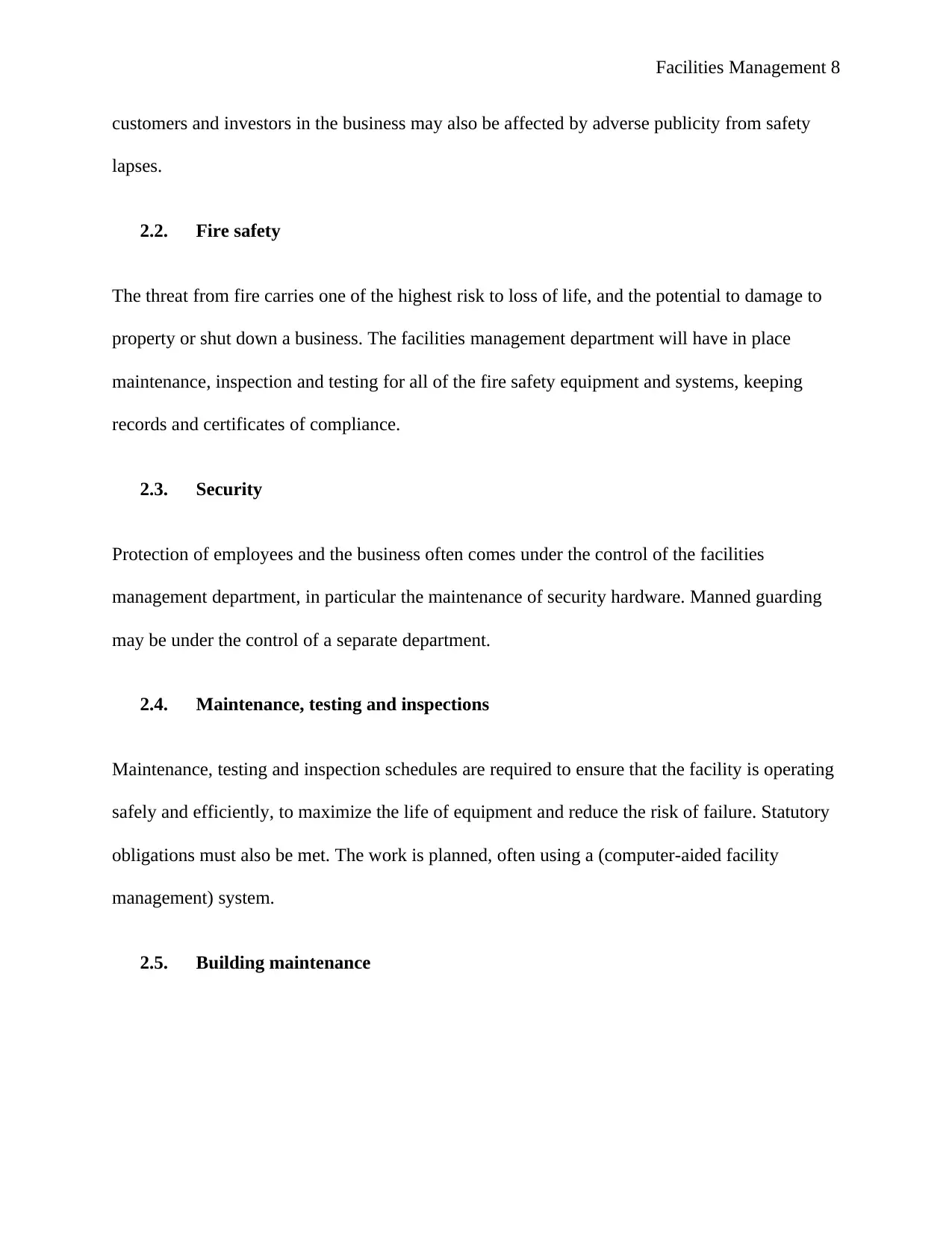
Facilities Management 8
customers and investors in the business may also be affected by adverse publicity from safety
lapses.
2.2. Fire safety
The threat from fire carries one of the highest risk to loss of life, and the potential to damage to
property or shut down a business. The facilities management department will have in place
maintenance, inspection and testing for all of the fire safety equipment and systems, keeping
records and certificates of compliance.
2.3. Security
Protection of employees and the business often comes under the control of the facilities
management department, in particular the maintenance of security hardware. Manned guarding
may be under the control of a separate department.
2.4. Maintenance, testing and inspections
Maintenance, testing and inspection schedules are required to ensure that the facility is operating
safely and efficiently, to maximize the life of equipment and reduce the risk of failure. Statutory
obligations must also be met. The work is planned, often using a (computer-aided facility
management) system.
2.5. Building maintenance
customers and investors in the business may also be affected by adverse publicity from safety
lapses.
2.2. Fire safety
The threat from fire carries one of the highest risk to loss of life, and the potential to damage to
property or shut down a business. The facilities management department will have in place
maintenance, inspection and testing for all of the fire safety equipment and systems, keeping
records and certificates of compliance.
2.3. Security
Protection of employees and the business often comes under the control of the facilities
management department, in particular the maintenance of security hardware. Manned guarding
may be under the control of a separate department.
2.4. Maintenance, testing and inspections
Maintenance, testing and inspection schedules are required to ensure that the facility is operating
safely and efficiently, to maximize the life of equipment and reduce the risk of failure. Statutory
obligations must also be met. The work is planned, often using a (computer-aided facility
management) system.
2.5. Building maintenance
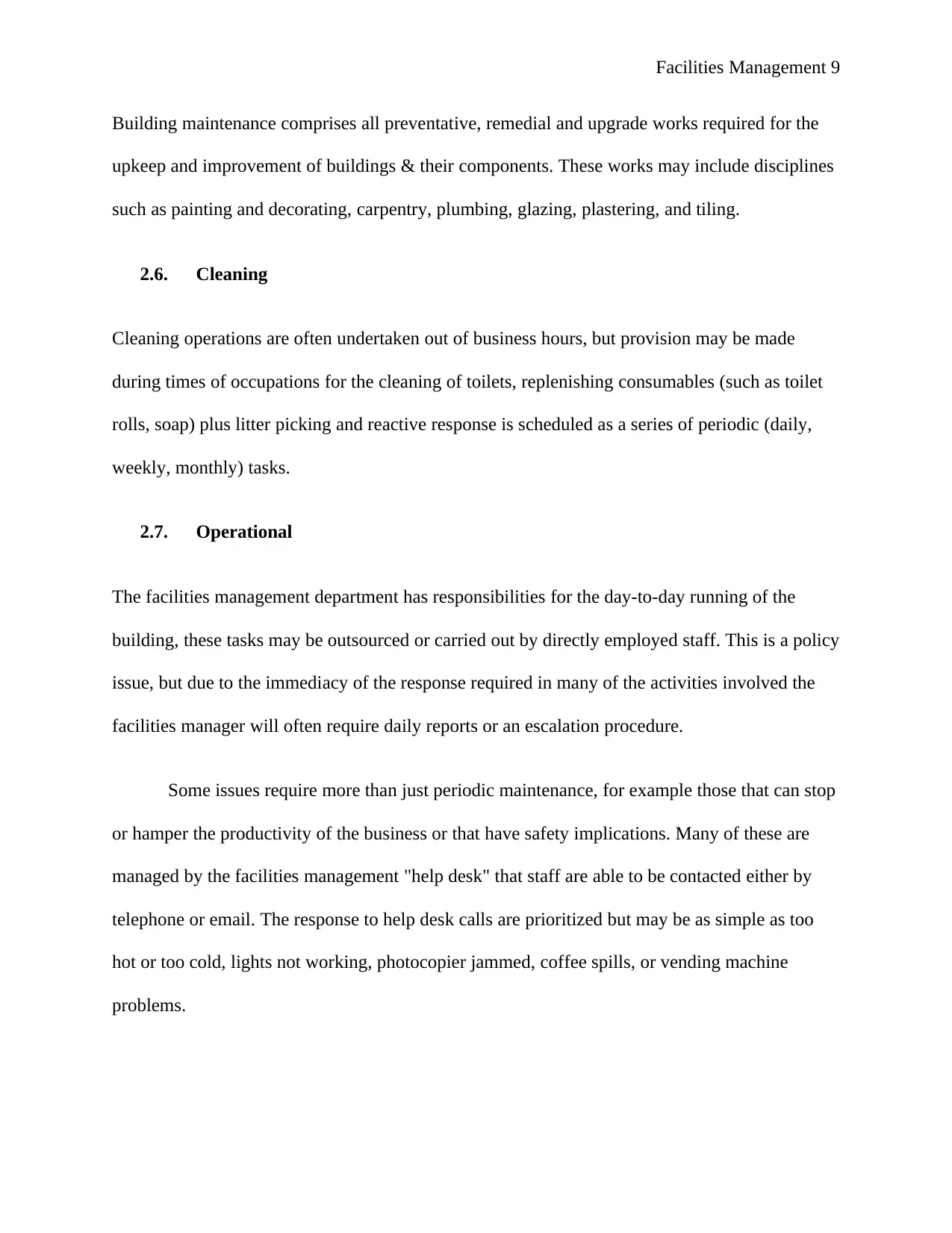
Facilities Management 9
Building maintenance comprises all preventative, remedial and upgrade works required for the
upkeep and improvement of buildings & their components. These works may include disciplines
such as painting and decorating, carpentry, plumbing, glazing, plastering, and tiling.
2.6. Cleaning
Cleaning operations are often undertaken out of business hours, but provision may be made
during times of occupations for the cleaning of toilets, replenishing consumables (such as toilet
rolls, soap) plus litter picking and reactive response is scheduled as a series of periodic (daily,
weekly, monthly) tasks.
2.7. Operational
The facilities management department has responsibilities for the day-to-day running of the
building, these tasks may be outsourced or carried out by directly employed staff. This is a policy
issue, but due to the immediacy of the response required in many of the activities involved the
facilities manager will often require daily reports or an escalation procedure.
Some issues require more than just periodic maintenance, for example those that can stop
or hamper the productivity of the business or that have safety implications. Many of these are
managed by the facilities management "help desk" that staff are able to be contacted either by
telephone or email. The response to help desk calls are prioritized but may be as simple as too
hot or too cold, lights not working, photocopier jammed, coffee spills, or vending machine
problems.
Building maintenance comprises all preventative, remedial and upgrade works required for the
upkeep and improvement of buildings & their components. These works may include disciplines
such as painting and decorating, carpentry, plumbing, glazing, plastering, and tiling.
2.6. Cleaning
Cleaning operations are often undertaken out of business hours, but provision may be made
during times of occupations for the cleaning of toilets, replenishing consumables (such as toilet
rolls, soap) plus litter picking and reactive response is scheduled as a series of periodic (daily,
weekly, monthly) tasks.
2.7. Operational
The facilities management department has responsibilities for the day-to-day running of the
building, these tasks may be outsourced or carried out by directly employed staff. This is a policy
issue, but due to the immediacy of the response required in many of the activities involved the
facilities manager will often require daily reports or an escalation procedure.
Some issues require more than just periodic maintenance, for example those that can stop
or hamper the productivity of the business or that have safety implications. Many of these are
managed by the facilities management "help desk" that staff are able to be contacted either by
telephone or email. The response to help desk calls are prioritized but may be as simple as too
hot or too cold, lights not working, photocopier jammed, coffee spills, or vending machine
problems.
⊘ This is a preview!⊘
Do you want full access?
Subscribe today to unlock all pages.

Trusted by 1+ million students worldwide
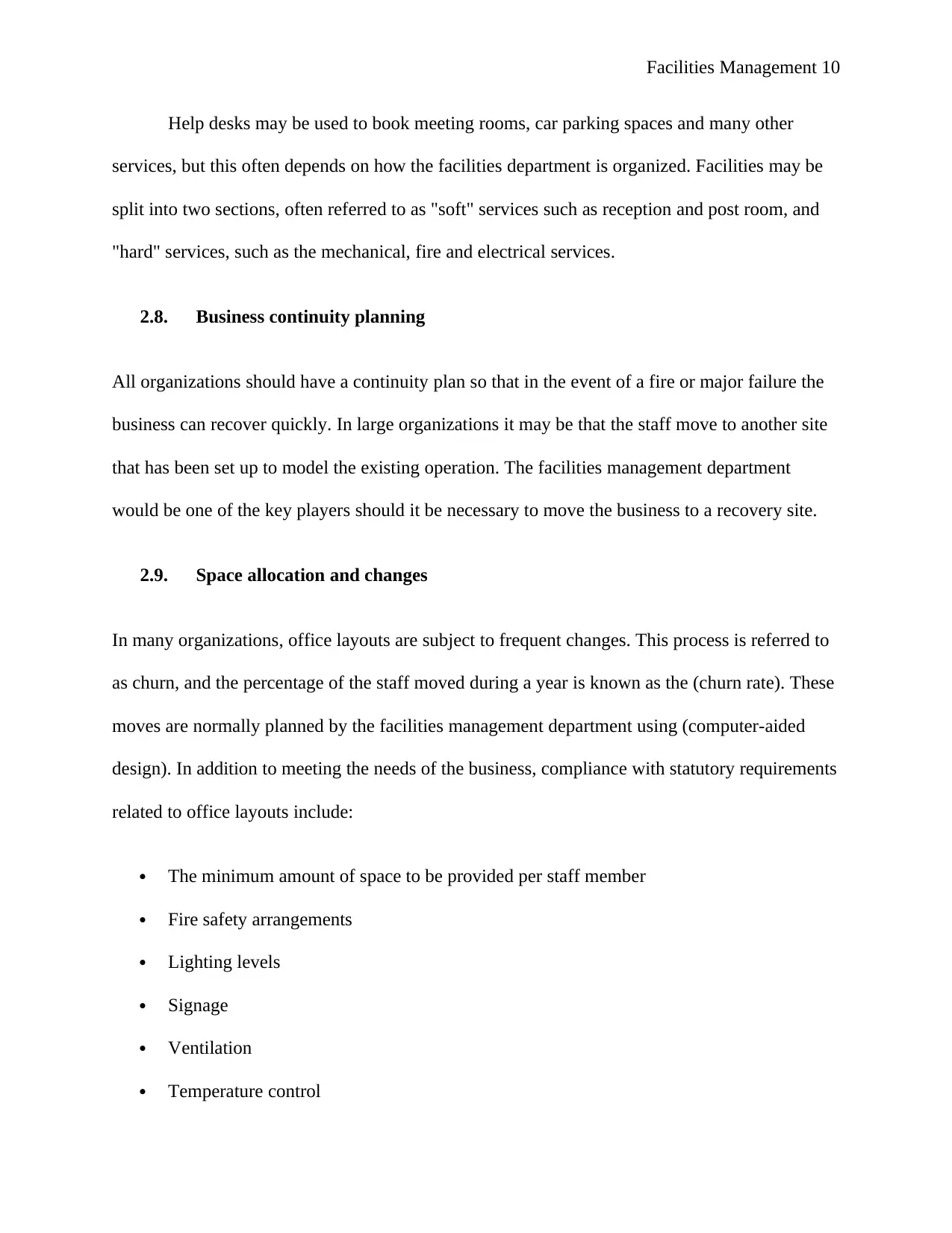
Facilities Management 10
Help desks may be used to book meeting rooms, car parking spaces and many other
services, but this often depends on how the facilities department is organized. Facilities may be
split into two sections, often referred to as "soft" services such as reception and post room, and
"hard" services, such as the mechanical, fire and electrical services.
2.8. Business continuity planning
All organizations should have a continuity plan so that in the event of a fire or major failure the
business can recover quickly. In large organizations it may be that the staff move to another site
that has been set up to model the existing operation. The facilities management department
would be one of the key players should it be necessary to move the business to a recovery site.
2.9. Space allocation and changes
In many organizations, office layouts are subject to frequent changes. This process is referred to
as churn, and the percentage of the staff moved during a year is known as the (churn rate). These
moves are normally planned by the facilities management department using (computer-aided
design). In addition to meeting the needs of the business, compliance with statutory requirements
related to office layouts include:
The minimum amount of space to be provided per staff member
Fire safety arrangements
Lighting levels
Signage
Ventilation
Temperature control
Help desks may be used to book meeting rooms, car parking spaces and many other
services, but this often depends on how the facilities department is organized. Facilities may be
split into two sections, often referred to as "soft" services such as reception and post room, and
"hard" services, such as the mechanical, fire and electrical services.
2.8. Business continuity planning
All organizations should have a continuity plan so that in the event of a fire or major failure the
business can recover quickly. In large organizations it may be that the staff move to another site
that has been set up to model the existing operation. The facilities management department
would be one of the key players should it be necessary to move the business to a recovery site.
2.9. Space allocation and changes
In many organizations, office layouts are subject to frequent changes. This process is referred to
as churn, and the percentage of the staff moved during a year is known as the (churn rate). These
moves are normally planned by the facilities management department using (computer-aided
design). In addition to meeting the needs of the business, compliance with statutory requirements
related to office layouts include:
The minimum amount of space to be provided per staff member
Fire safety arrangements
Lighting levels
Signage
Ventilation
Temperature control
Paraphrase This Document
Need a fresh take? Get an instant paraphrase of this document with our AI Paraphraser
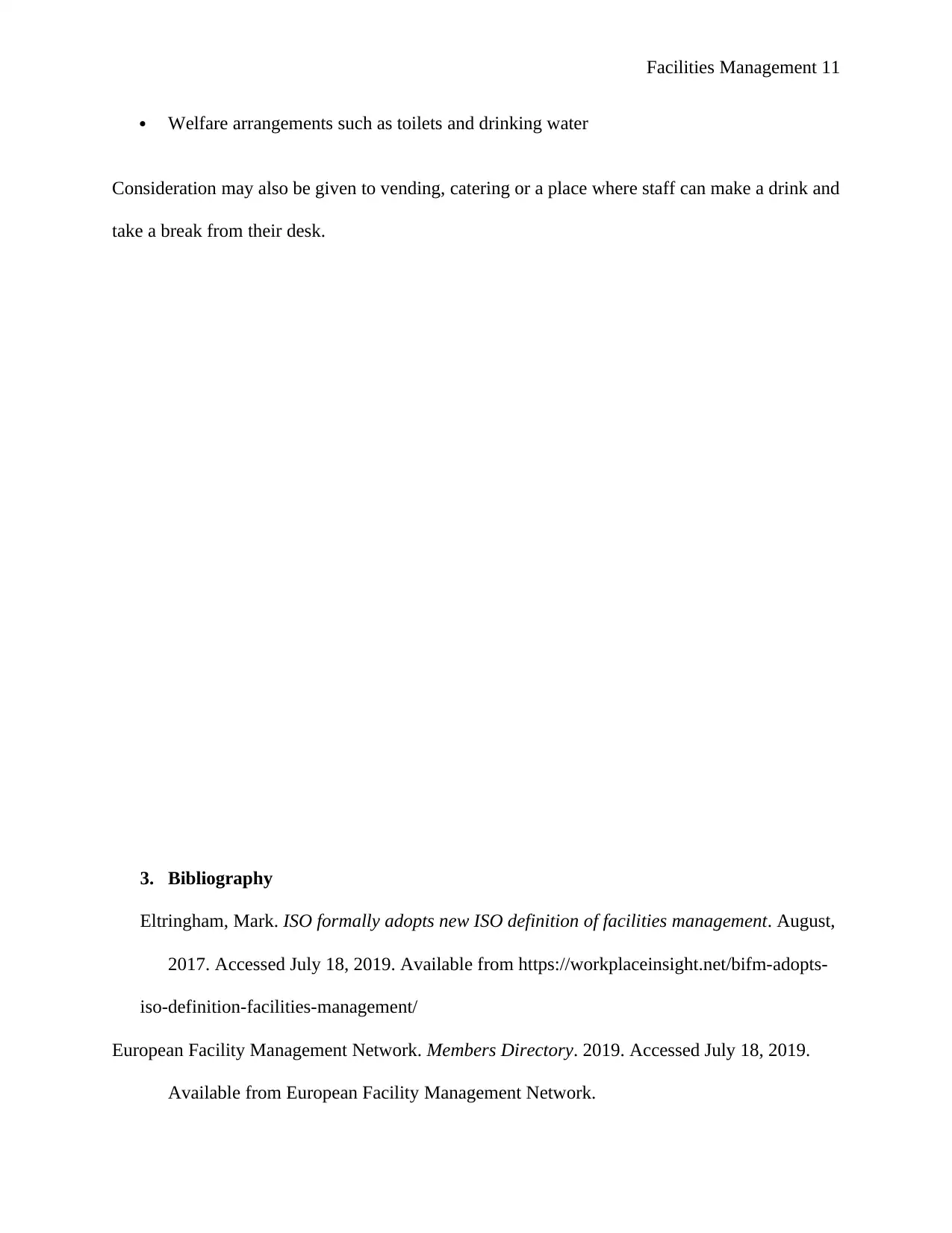
Facilities Management 11
Welfare arrangements such as toilets and drinking water
Consideration may also be given to vending, catering or a place where staff can make a drink and
take a break from their desk.
3. Bibliography
Eltringham, Mark. ISO formally adopts new ISO definition of facilities management. August,
2017. Accessed July 18, 2019. Available from https://workplaceinsight.net/bifm-adopts-
iso-definition-facilities-management/
European Facility Management Network. Members Directory. 2019. Accessed July 18, 2019.
Available from European Facility Management Network.
Welfare arrangements such as toilets and drinking water
Consideration may also be given to vending, catering or a place where staff can make a drink and
take a break from their desk.
3. Bibliography
Eltringham, Mark. ISO formally adopts new ISO definition of facilities management. August,
2017. Accessed July 18, 2019. Available from https://workplaceinsight.net/bifm-adopts-
iso-definition-facilities-management/
European Facility Management Network. Members Directory. 2019. Accessed July 18, 2019.
Available from European Facility Management Network.
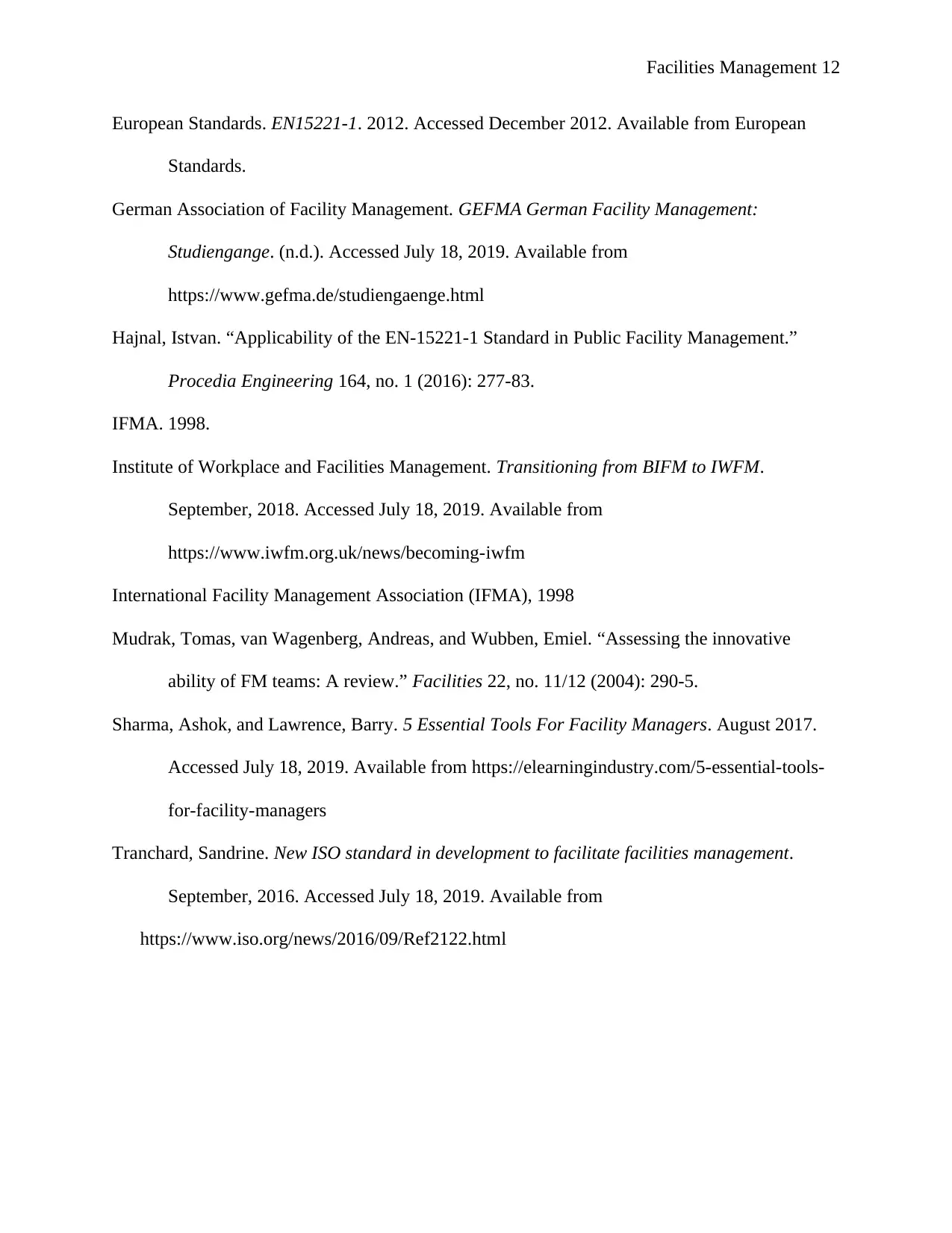
Facilities Management 12
European Standards. EN15221-1. 2012. Accessed December 2012. Available from European
Standards.
German Association of Facility Management. GEFMA German Facility Management:
Studiengange. (n.d.). Accessed July 18, 2019. Available from
https://www.gefma.de/studiengaenge.html
Hajnal, Istvan. “Applicability of the EN-15221-1 Standard in Public Facility Management.”
Procedia Engineering 164, no. 1 (2016): 277-83.
IFMA. 1998.
Institute of Workplace and Facilities Management. Transitioning from BIFM to IWFM.
September, 2018. Accessed July 18, 2019. Available from
https://www.iwfm.org.uk/news/becoming-iwfm
International Facility Management Association (IFMA), 1998
Mudrak, Tomas, van Wagenberg, Andreas, and Wubben, Emiel. “Assessing the innovative
ability of FM teams: A review.” Facilities 22, no. 11/12 (2004): 290-5.
Sharma, Ashok, and Lawrence, Barry. 5 Essential Tools For Facility Managers. August 2017.
Accessed July 18, 2019. Available from https://elearningindustry.com/5-essential-tools-
for-facility-managers
Tranchard, Sandrine. New ISO standard in development to facilitate facilities management.
September, 2016. Accessed July 18, 2019. Available from
https://www.iso.org/news/2016/09/Ref2122.html
European Standards. EN15221-1. 2012. Accessed December 2012. Available from European
Standards.
German Association of Facility Management. GEFMA German Facility Management:
Studiengange. (n.d.). Accessed July 18, 2019. Available from
https://www.gefma.de/studiengaenge.html
Hajnal, Istvan. “Applicability of the EN-15221-1 Standard in Public Facility Management.”
Procedia Engineering 164, no. 1 (2016): 277-83.
IFMA. 1998.
Institute of Workplace and Facilities Management. Transitioning from BIFM to IWFM.
September, 2018. Accessed July 18, 2019. Available from
https://www.iwfm.org.uk/news/becoming-iwfm
International Facility Management Association (IFMA), 1998
Mudrak, Tomas, van Wagenberg, Andreas, and Wubben, Emiel. “Assessing the innovative
ability of FM teams: A review.” Facilities 22, no. 11/12 (2004): 290-5.
Sharma, Ashok, and Lawrence, Barry. 5 Essential Tools For Facility Managers. August 2017.
Accessed July 18, 2019. Available from https://elearningindustry.com/5-essential-tools-
for-facility-managers
Tranchard, Sandrine. New ISO standard in development to facilitate facilities management.
September, 2016. Accessed July 18, 2019. Available from
https://www.iso.org/news/2016/09/Ref2122.html
⊘ This is a preview!⊘
Do you want full access?
Subscribe today to unlock all pages.

Trusted by 1+ million students worldwide
1 out of 14
Related Documents
Your All-in-One AI-Powered Toolkit for Academic Success.
+13062052269
info@desklib.com
Available 24*7 on WhatsApp / Email
![[object Object]](/_next/static/media/star-bottom.7253800d.svg)
Unlock your academic potential
Copyright © 2020–2025 A2Z Services. All Rights Reserved. Developed and managed by ZUCOL.





